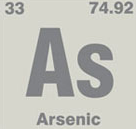
In my recent article about the slow release of money from the state for a program to address lead contamination across New Orleans, I wrote about arsenic levels in soil that are supposed to trigger a clean-up under state Department of Environmental Quality policy. In a document sent to me from DEQ entitled “Arsenic sampling results explained,” it reads, “In Louisiana, the DEQ residential clean-up level for arsenic is 12 ppm,” or parts per million.
This is the clean-up standard that local environmental scientists and the Natural Resources Defense Council used when they took samples of soil in the 18 months after Hurricane Katrina. What they found were startling levels of arsenic from sediment that was spread over the city from floods. They also found high levels near some schools and playgrounds.
By one school, arsenic was found at levels almost three times the DEQ threshold, which led the Defense Council to put out an alert.
But Tom Harris, administrator of remediation services at DEQ, doesn’t believe the alert was appropriate.
“I think the confusion is that NRDC used inappropriate standards,” said Harris. “There is less disagreement over what is in the soil and more disagreement over what the data means.”
Harris said the safe level is not 12 but 22 parts per million. DEQ officials also took soil samples after Katrina and analyzed their numbers to determine both possible carcinogenic and non-carcinogenic risks before deciding on that threshold. The 12 ppm number is the “background level,” said Harris, meaning it’s the average level of arsenic one would find anywhere in the state.
So what about that document his office created in January 2006, saying 12 was the threshold for a clean-up?
“That is a poorly worded statement,” Harris said. “I haven’t looked at that document in a really long time.”
DEQ collected samples at four of the schools for which the Defense Council put out alerts. In some areas that DEQ tested, elevated levels are found – one sample area at John Dibert Elementary recorded 40 ppm. But the seven other samples at Dibert showed lower levels, and the DEQ takes an average for a site. The Dibert site average was not high enough to trigger a cleanup. Harris said on his end, “We found the same thing we found everywhere else.” That was an average of 12 ppm or lower.
As for the Defense Council’s data that say otherwise: “It’s not a matter of conflicting data, it is a lie,” said Harris, adding that the Defense Council, which is headquartered in New York never shared their data with DEQ.
“They have seen our data,” says Miriam Rotkin-Ellman, one of the lead Defense Council scientists on the matter. She said DEQ used methodologies in gathering and analyzing samples that her colleagues find fault with.
The Defense Council has reviewed the DEQ test results, which show arsenic levels are higher than the 12 ppm, but not as high as those recorded by the Defense Council.
The problem, said Rotkin-Ellman, is that DEQ has made the arsenic guideline numbers a “moving target,” and this has made it difficult for residents to understand just how much of threat exists in yards where kids play and go to school. In an early document they have from DEQ, it states the clean-up guideline is 7 ppm.
“You can cut and slice these data and risk levels a lot of different ways, and LDEQ has done a lot to change the numbers to make it fit their decision that there is no risk here,” said Rotkin-Ellman. “Our analysis showed that after Hurricane Katrina, the levels of arsenic in the soils were elevated substantially. We tested again a year-and-a-half later and found that in some places we continued to see some higher arsenic levels and that there is a reason to be concerned, and to do additional testing.
“We should hone in on a clean-up level produced in terms of how much exposure the communities want to have their children exposed to.”
